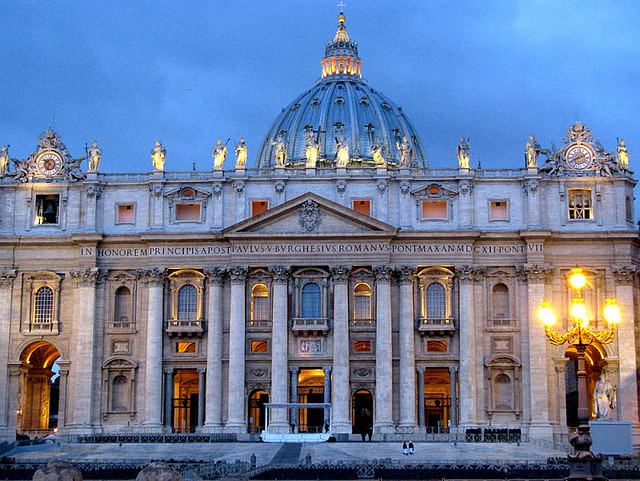
Now that Argentina’s Jorge Mario Bergoglio has been named the new pope, Vatican City can get back to the usual business for this time of year — celebrating Holy Week. With the help of Markus Dobritzhofer, chef concierge at Waldorf Astoria Hotels and Resorts’ Rome Cavalieri, we get the inside scoop for Rome visitors who want to know more about the world’s smallest independent nation, including tips on the Vatican’s must-see attractions and the best way to catch a glimpse of Pope Francis I.
What do you think is the best way to see the Vatican?
The best type of visit depends on the visitor. To visit the Vatican’s incredible artwork, it’s not necessary to take a tour; you will be just as impressed if you go by yourself. Take advantage of the efficient reservation system on the Vatican Museums’ website—especially during high season, when the lines can be very long. Make a reservation for simple entrance tickets ahead of time to enter directly.
Tours are the best option if you’re interested in learning about the history and artwork inside; you have to [allot] three to four hours to tour the highlights of the Museums, Sistine Chapel and St. Peter’s Basilica. Group tours can be more convenient and can usually be booked at the last moment—they follow a fixed program and time schedule.
On an individual tour, the professional tour guide can give you more attention and can take you to important sections of the Museums that are usually not included in the standard itineraries (like the Pinacoteca Vaticana art gallery). For this type of tour, it’s possible to choose different times of the day. Another advantage of the tour arrangements—both group and individual—is the guides are authorized to take visitors directly from the Sistine Chapel to St. Peter’s Basilica, while individual visitors cannot.
An exclusive private visit is for sure a unique experience. The guests for whom I’ve arranged this type of visit experienced great emotion inside the Sistine Chapel, just being surrounded by all the world-famous paintings and the very unusual silence and emptiness. Of course, it’s necessary to plan this type of visit ahead of time, as very few are authorized by the Vatican Museums—sometimes months ahead is not even enough time.
What are the must-see attractions at the Vatican for a first-time visitor?
The Vatican Museums and the Sistine Chapel; the Museums have many different sections and those usually included in every guided visit are: the Pio-Clementino (classic antiquities); Gregorian Etruscan and Egyptian museums; the Raphael Rooms; the Gallery of the Candelabra, Gallery of Maps and Gallery of Tapestries; and, of course, St. Peter’s Basilica.
When is the best time to visit the Vatican?
The key point to know about the Vatican (the Museums, the Sistine Chapel and St. Peter’s) is that it is very crowded throughout almost the entire year. It is nice to visit during January and February or the end of November and early December, when it’s quieter.
Mornings until midday are very popular and busy. In the early afternoon, it becomes less crowded; however, it’s necessary to enter the Vatican Museums before 3 p.m. to reach the Sistine Chapel before it closes. On Mondays, the Vatican Museums and Sistine Chapel might be busier than the rest of the week, and both are closed on Sundays, though there is free entrance the last Sunday of every month. Also, take into consideration days when big events take place, like Wednesdays’ general audience with the pope. You can now also visit some sections of the Vatican Museums and Sistine Chapel during the evening, every Friday from 7 to 9 p.m., May through October; a reservation is mandatory.
Is there an often-overlooked part of the Vatican that visitors miss?
There are some important sections inside the Museums that are usually not included in tour itineraries, but are absolutely worth a visit. The Pinacoteca Vaticana houses paintings from Giotto, Beato Angelico, Melozzo da Forlì, Pietro Perugino and Michelangelo Merisi da Caravaggio. You’ll also see Raphael’s Transfiguration—“the most famous, the most beautiful and most divine” of his works, according to 16th-century Raphael biographer Giorgio Vasari. Another overlooked gem is the Carriage Pavilion, established by Pope Paul VI in 1967. The Carriage Pavilion holds the portraits of pontiffs from 1500 to the present, all the papal ceremonial apparatus, and the arms and uniforms of the Pontifical Armed Corps.
What are your tips for visitors who would like to see the pope in person?
The appointments to see the pope have a long tradition and visitors have several options. First, there’s the general audience; on Wednesdays when the pope is in the Vatican, he gives a general audience to the public, either in the Audience Hall (usually during winter) or in St. Peter’s Square. If you obtain a free ticket, you have a better chance of getting a seat. Then there’s the Sunday blessing. At noon on Sundays, the pope usually gives his blessing from the window of his office above St. Peter’s Square. There are also special celebrations—for example, midnight mass on Christmas Eve is celebrated by the pope. For that, you should request tickets directly from the Prefettura Vaticana ahead of time.
Usually the pope spends from July until the middle or end of September in his summer residence in Castel Gandolfo in the area of the Castelli Romani. It would be worth a nice half-day or day trip from Rome to see him give the Sunday blessing. Last but not least, the pope is also the Bishop of Rome and therefore visits local churches several times a year; this can be a completely different experience, among local people in unknown suburbs of Rome.
Photo Courtesy of iStock-S.Greg Panosian

